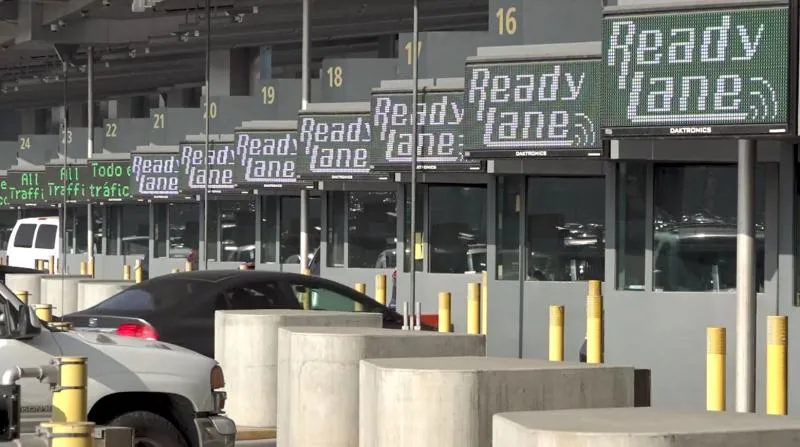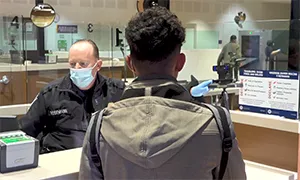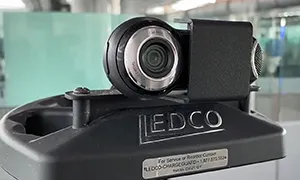In this Update
- Message from the Acting Deputy Assistant Commissioner
- Easing Travel Restrictions at our Borders
- CBP on the Hill: Modernizing Land Ports of Entry
- CBP One™ Streamlines Travel to the United States
- Simplified Arrival Expands at Land Ports of Entry
- U.S. NEXUS/FAST Enrollment Centers to Re-Open
- Enforcement News from Across CBP
CBP Access is an electronic newspage developed by the Office of Congressional Affairs for Members of Congress and staff. If you are interested in subscribing to the CBP Access email distribution list, please send an email to OCAInquiry@cbp.dhs.gov.
Message from the Acting Deputy Assistant Commissioner
CBP operations at the nation’s ports of entry are critical to ensure safe and efficient travel across our borders. Before the COVID-19 global pandemic, CBP officers would process nearly a million travelers every day. As international travel begins to return to normal levels, CBP is prepared to welcome and facilitate travelers, while maintaining the highest standards of security. While travel had been restricted during the pandemic, CBP continued to make progress toward upgrading facilities, incorporating effective technology, and implementing innovative solutions to streamline processes for travelers, while also addressing the ever-evolving challenges and threats at and beyond our borders.
–Patrick Schmidt, Acting Deputy Assistant Commissioner
Easing Travel Restrictions at our Land Borders

As of Monday, November 8, 2021, new requirements went into effect for travelers entering the United States at land ports of entry and ferry terminals. Non-citizen travelers are now permitted to enter the United States through a land border or ferry terminal for a non-essential reason (i.e., tourism), provided they are fully vaccinated and can present proof of COVID-19 vaccination status. Unvaccinated travelers may continue to cross the border for essential travel, including lawful trade, emergency response, and public health purposes. This shift eases long-standing restrictions on non-essential travel, consistent with public health guidance.
When arriving at a U.S. land POE or ferry terminal, non-citizen travelers should be prepared to (1) provide proof of COVID-19 vaccination, as outlined on the Centers for Disease Control (CDC) website; and (2) verbally attest to their reason for travel and COVID-19 vaccination status during a border inspection.
Any non-citizen attempting to enter the United States through illegal means or without appropriate documentation may be subject to expulsion or removal. Travelers arriving at a U.S. land port of entry or ferry terminal should be prepared to present any other relevant documents as requested by a CBP officer. U.S. citizens are reminded to bring a Western Hemisphere Travel Initiative (WHTI) document, such as a valid U.S. passport, Trusted Traveler Program card, Enhanced Driver’s License, or Enhanced Tribal Card, when re-entering the country. To learn more about the updated requirements for travelers, please review the Fact Sheet: Guidance for Travelers to Enter the U.S. at Land Ports of Entry and Ferry Terminals.

Individuals engaged in essential travel will not be required to be vaccinated for COVID-19 at this time. Starting in January 2022, however, all inbound foreign national travelers seeking to enter the United States via land POEs or ferry terminals – whether for essential or non-essential reasons – must be fully vaccinated for COVID-19 and provide related proof of vaccination.
To help reduce wait times and long lines, travelers can take advantage of innovative technology, such as the CBP One™ mobile application, which allows travelers to apply for a provisional I-94 prior to arriving at a land border crossing, and Simplified Arrival, which process provides travelers with a secure, touchless travel experience.
CBP On the Hill: Modernizing our Land Ports of Entry

Deputy Executive Assistant Commissioner
Diane Sabatino
On Wednesday, November 17, 2021, CBP Office of Field Operations Deputy Executive Assistant Commissioner (DEAC) Diane Sabatino testified before the Senate Homeland Security Subcommittee on Government Operations and Border Management for a hearing titled, “Federal Government Perspective: Improving Security, Trade, and Travel Flows at Southwest Border Ports of Entry.”

the Southwest Border
During the hearing, DEAC Sabatino discussed the importance of CBP's role at our nation's land ports of entry and highlighted how the integration of advance technology into infrastructure and business processes, such as the expansion of CBP One, Simplified Arrival and non-intrusive inspection technology enables CBP to intercept high-risk travelers and other threats while also streamlining and expediting the flow of legitimate trade and travel.
Other witnesses on the panel were Joe Jeronimo, Deputy Assistant Director, Transnational Organized Crime Division, Homeland Security Investigations, U.S. Immigration and Customs Enforcement; and Stuart Burns, Assistant Commissioner, Public Buildings Service, Portfolio Management and Customer Engagement, General Services Administration. DEAC Sabatino's full written testimony can be found on CBP.gov and a recorded webcast of the hearing can be found on the Subcommittee’s Website.
CBP's Updated App Streamlines Travel to the United States

As part of CBP’s comprehensive effort to improve the security of our nation’s borders while enhancing legitimate travel and trade, CBP One™ serves as a single point of entry for travelers and stakeholders to access CBP mobile applications and services. Through a series of intuitive questions, the app guides guide each user to the appropriate services based on their needs.

CBP One™ began the rollout of its features in October 2020, starting with an Inspection Appointment request feature for brokers/carriers/forwarders and I-94 Entry for travelers. The Inspection Appointment request feature allows brokers/carriers/forwarders to request an inspection time for perishable cargo entering the U.S. Each request is assigned to a CBP agriculture specialist who oversees assigning inspection times and communicates with the requestor via an interactive chat feature if additional information is needed.
The I-94 Entry feature allows travelers to apply for a provisional I-94 prior to arriving at a land border crossing. Travelers who apply for their I-94 ahead of time will experience faster processing times to expedite entry. Travelers can also quickly access their current I-94 submission to view critical information such as, how long they can remain in the U.S., and use it for proof of visitor status once in the United States.
On November 22, 2021, CBP announced a new feature in the CBP One™ mobile application that will be able to better facilitate international travel into the United States. Beginning November 30, CBP’s agriculture specialists will be able to receive advanced notification of travelers who require inspection of agriculture and biological products upon arrival at an airport in the United States. Providing advance information and scheduling appointments may expedite travelers’ CBP clearance upon arrival. Categories for declaration will include:
- Biological materials that may require permits issued by the U.S. Department of Agriculture (USDA) and the Centers for Disease Control and Prevention (CDC)
- Pets, specifically birds and dogs, accompanying travelers in various capacities that carry the potential of introducing foreign animal diseases to the U.S. or other public health concerns
- Cleaning and disinfection of shoes
- Hunting trophies
Moving the agriculture process to CBP One™ will give travelers more transparency throughout the request process, including real-time status updates by way of pushed notifications, which can also be sent to a group email. Travelers can also upload documents such as accompanying permits, certificates, or statements of non-infectiousness for CBP review prior to arrival.
The capability is available at the following airports: Boston Logan International Airport (BOS); Chicago O’Hare International (ORD); Dallas Fort-Worth International Airport (DFW); Ft. Lauderdale International Airport (FLL); Houston International Airport (IAH); JFK International Airport (JFK); Los Angeles International Airport (LAX); Miami International Airport (MIA); Washington Dulles International (IAD); Newark International Airport (EWR); San Francisco International Airport (SFO); and Seattle-Tacoma International Airport (SEA).
CBP.gov provides an overview of CBP One™ features and information on how to start using the app. The CBP One app can be downloaded for free from the Apple App Store or Google Play.
Simplified Arrival at Land Ports of Entry

traveler at a pedestrian border crossing.
With an increasingly complex threat posture in the land border environment, CBP continues to expand efforts to streamline traveler processing. Capturing biometrics, specifically using facial comparison technology, provides CBP an efficient and secure way to verify identity of persons entering and exiting the United States.
CBP's Simplified Arrival - Biometrics process provides travelers with a secure, touchless travel experience while fulfilling a longstanding Congressional mandate to biometrically record the entry and exit of non-U.S. citizens. This process uses biometric facial comparison technology to automate the manual document checks that are already required for admission into the United States at nearly all airports, including preclearance locations.
Deployment of this capability to land ports of entry has been comparatively slower considering the additional geographical and operational challenges; however, CBP is working to implement biometric capabilities at all land ports of entry in the pedestrian, personal vehicle, and commercial vehicle environments. Currently, CBP’s biometric facial comparison technology is deployed to all pedestrian ports of entry along the Southwest Border, 21 ports of entry along the Northern Border, and 10 locations for closed-loop cruises.
Biometric processing has proven an effective tool to combat the use of stolen and fraudulent travel and identity documents. Since the program’s inception in 2018, CBP officers at LPOEs have identified over 950 imposters attempting to enter the United States.
In April 2021, the biometric functionality for processing commercial truck drivers and passengers at primary inspection was integrated into the new Truck Manifest Modernization cargo processing system. Furthermore, CBP began conducting a technical demonstration in September 2021 to test using facial biometric capture camera technology on vehicle travelers in vehicle primary lanes at Anzalduas, Texas.
The biometric facial comparison process occurs only at a time and place where travelers are already required by law to verify their identity by presenting a travel document. When a traveler arrives at one of the pedestrian lanes or undergoes I-94 processing, he or she will pause for a photo at the primary inspection point. A CBP officer will review and query the travel document, which will retrieve the traveler’s passport or visa photo from government holdings and compare it to the new photo.

This enhanced process using facial biometrics only takes a few seconds and is more than 98 percent accurate. In addition, foreign travelers who have traveled to the United States previously may no longer need to provide fingerprints, as their identity will be confirmed through the touchless facial biometric process.
CBP is committed to its privacy obligations and has taken steps to safeguard the privacy of all travelers. CBP has employed strong technical security safeguards and has limited the amount of personally identifiable information used in the facial biometric process. New photos of U.S. citizens will be deleted within 12 hours. Photos of most foreign nationals will be stored in a secure U.S. Department of Homeland Security system.
U.S. travelers and foreign nationals who are not required to provide biometrics and wish to opt out of the new biometric process may notify a CBP officer as they approach the primary inspection point. These travelers will be required to present a valid travel document for inspection by a CBP officer and will be processed consistent with existing requirements for admission into the United States.
Simplified Arrival pairs one of the industry’s highest ranked facial comparison algorithms (as assessed by the National Institute of Standards and Technology) with trained CBP officers who are skilled at verifying the authenticity of travel documents. If a traveler cannot be matched to a photo on record using the Simplified Arrival process, the traveler will proceed through the traditional inspection process consistent with existing requirements for admission into the United States.
To date, more than 70 million travelers have participated in the CBP biometric facial comparison process at air, land, and seaports of entry.
U.S. NEXUS/FAST Enrollment Centers to Re-Open November 29

CBP recently announced that the NEXUS and U.S./Canada FAST enrollment centers in the United States will reopen on November 29, 2021. It should be noted, however, that the NEXUS and FAST enrollment centers in Canada will continue to be closed until further notice.
NEXUS is a program run jointly between CBP and the Canada Border Services Agency (CBSA). It is designed to speed up border crossings for low-risk, pre-approved travelers into Canada and the United States. FAST is a joint program between the CBSA and CBP that enhances border and trade security while making cross-border commercial shipments simpler and subject to fewer delays.
Conditionally approved applicants may schedule interviews at available NEXUS and U.S./Canada FAST enrollment centers in the United States. Appointments must be booked through the Trusted Traveler portal: https://ttp.dhs.gov and will have dates available starting November 29. Applicants entering the U.S. to complete their interview must meet all applicable travel requirements.
CBP asks all applicants to be patient with the system as there is large backlog of applications to be processed by a limited number of open enrollment centers. In order to prioritize new applicants needing interviews, CBP is asking existing NEXUS and FAST members to refrain from booking an appointment at this time. However, existing members are encouraged to renew their membership before their expiry date on their cards to maintain their membership benefits until able to complete their interviews at a later time.
New applicants can apply for membership at https://ttp.dhs.gov. The non-refundable application fee for a five-year FAST membership is $50 and applications must be submitted online. Once the applicant successfully passes a background check, a CBP officer will conduct an interview with the applicant at select locations in the United States to make a final eligibility determination.
Enforcement News From Across CBP
CBP Intercepts 47 Live Roosters at Laredo Port of Entry

Laredo, TX — CBP officers and agriculture specialists at the Laredo Port of Entry recently intercepted a large clutch of live poultry hidden throughout a vehicle. The incident happened on the evening of November 12th, when a United States citizen made entry via the SENTRI lane and was referred for inspection by CBP officers. At secondary, CBP officers discovered live poultry in stockings under the front seats. Because of the nature of the findings, CBP agriculture specialists were called in to assist with the inspection. CBP personnel encountered more live poultry inside the purse of the passenger. In all, 47 live birds were found concealed underneath the seats, floor mats, inside the glove compartment and trunk of the vehicle.
CBP Officers Seize $137K in Cocaine

Brownsville, TX — CBP officers at the Veterans International Bridge recently intercepted a load of alleged cocaine, hidden within a 2013 Nissan. The seizure took place on November 17 at Veterans International Bridge when a 21-year-old female U.S. citizen who resides in Brownsville, attempted entry into the United States. The vehicle was referred to CBP secondary for further examination after a primary inspection. While in the secondary inspection area, with the aid of a canine unit, CBP officers discovered six packages hidden within the vehicle. CBP officers removed the packages which contained a total of 17.76 pounds of alleged cocaine. The estimated street value of the cocaine from the seizure is $137,020. CBP officers seized the narcotics along with the vehicle, arrested the driver and turned her over to the custody of Homeland Security Investigations (HSI) special agents for further investigation.
CBP Officers Arrest Fugitive Sought for Trafficking Children

El Paso, TX — CBP officers working at the Presidio port of entry arrested a 45-year-old U.S. citizen female who had an arrest warrant for trafficking children for sexual purposes. The apprehension occurred at approximately 6 a.m. on November 13 when CBP officers encountered a 2014 Mazda arriving from Mexico with four passengers. While conducting primary inspections on the vehicle and its occupants, a CBP officer identified the driver as having an outstanding warrant. CBP officers took the woman into custody and confirmed the warrant out of the Jefferson Parish Sheriff’s Office. The Presidio Police Department took custody of the suspect.
Office of Congressional Affairs | November 2021

